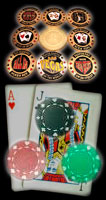CATEGORIZE A GAME
To make a judgment of the characteristics of a poker game you should watch the game for about ten hands.
The longer you can watch the game, the better, but ten hands is usually enough.
That will take about twenty to thirty minutes, maybe less. You’re looking for two things: how many players see the flop and how often someone raises.
The criteria I use in this chapter assume a full game-nine or ten players.
Evaluation of a short-handed game requires a different approach. I discuss this later in this chapter.
Tight Table
A tight table is one with few players involved in each pot. You’ll see some tables where there are seldom more than two players involved in a pot.
If you see most flops involving two poker players, never more than three, that’s tight table. If you see a table where sometimes everyone folds to a single raise, that’s a very tight table.
Loose Table
A loose table is one with many players playing each hand.
If you see five or more players involved in most flops, that’s a loose table. If most flops have seven or more active hands, that’s a very loose table.
Passive Table
A passive table is one with very little raising. If, out of ten hands, you see no more than two hands with raises before the flop, consider that a passive game.
Aggressive Table
An aggressive table is one with frequent raises. If five or more of the ten pots have been raised, that’s an aggressive game.
A very aggressive game is one that is raised almost every pot. It’s a very aggressive game if eight or more of the pots have been raised and at least two of them involved the maximum number of raises.
The first table on page 92 shows the playing characteristics of twenty different combinations of game characteristics.
Twenty seems like a lot of different online poker game types of remember, but it’s really not. With just a little practice, you’ll learn to identify these game types automatically.
Except for very loose games, the aggressive and very aggressive games are often unprofitable, and the most important piece of strategy advice for those games is to avoid them.
The second table shows the various combinations of tight-loose and passive-aggressive scales with an assessment of how often they tend to be profitable.
The most profitable game is one that’s very loose and very aggressive scales with an assessment of how often they tend to be profitable.
The most profitable game is one that’s very loose and very aggressive. However, I’m talking about potential profitability.
There is no guarantee that you will realize that potential. Very loose, very aggressive games also tend to be very difficult to play.
What seems to be a good hand is often beaten by a long-shot hand. losing a pot to a player who is playing a poker hand that had very little chance of beating you is called a “bad beat.”
Sometimes players who suffer bad beats have an emotional response.
An extreme emotional response is called “going on tilt is one who is not thinking clearly, tends to be reacting to past events rather than the current situation, and makes a lot of mistakes.
The potential is there in the very loose, very aggressive games, although actually getting the money is something else again.
Unless you’re an experienced player, with good hand-reading skills, and don’t become tilted by a bad beat, then you should avoid these games.
Beginners, in particular, should avoid very aggressive games of all kinds.
Pick the Right Table / Picking a Seat / Theories of Poker / Betting Theory: The Odds
A Theory of Starting Hand Value
A Theory of Flop Play: Counting Outs and Evaluating Draws
The Dynamics of Game Conditions / Table Image / Player Stereotypes
Women and Poker / Spread-Limit Games / Double Bet on the End Games / Kill Games
Short-handed Games / Tournaments / No-limit and Pot-Limit Poker



